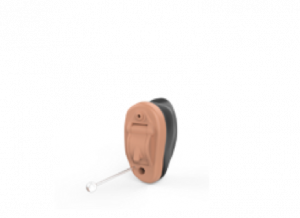Time To Read: 25 minutes
- The hearing aid you pick should be one that you are willing to wear
- Your best hearing aid choice is the one which is comfortable enough to wear for at least 4 hours a day
- The best hearing aid to choose is the one which suits your hearing loss configuration and severity
- You should be able to manage the hearing aid you choose
- Your choice of hearing aid should optimise your maximum ability to understand speech in quiet
- Your best hearing aid is the one which optimises your unique ability to understand speech in noise
- Choose a hearing aid that suits your lifestyle
- Your best hearing aid choice is the one which provides the best value without over- or under-prescribing
- Choosing a hearing aid you can afford
- How do I ensure I choose My Best Hearing Aid?
- Ask questions if answers aren’t forthcoming
- Make sure you have a sufficiently long trial period with the hearing aid of your choice
- Make sure you have an option to refund or exchange if things don’t work out as expected
Choosing a hearing aid is critically important because a wrong decision could haunt you for years. Part of the problem comes from how hearing aids are currently selected as well as retailer bias. Around 80% of clinics in Australia are owned by manufacturers, which may limit the options available to you. Many more only supply a handful of models, suited to their levels of profitability, rather than to your needs.
You might choose to do your own research, but with hundreds of models available to you, this is an almost impossible task. What makes things worse is that a hearing aid that might work exceptionally well for one person, may not suit another at all. So there is NO benefit to just asking around when it comes to choosing the hearing aid that will work best for you. The question of which hearing aid to select is a tricky one, requiring a detailed answer. I'll do my best to answer this for you below.
With all this against me, how do I choose the best hearing aid?
The hearing aid you select should be one that you are willing to wear
A less than perfect hearing aid in the ear is MUCH BETTER than the perfect, best hearing aid, sitting in a drawer.
As hearing professionals, we are always aiming to prescribe the best solutions to our clients within the resources available to us. Sometimes our optimal choice for you is not one you would ever consider wearing.
In circumstances like these, which fortunately are few and far between, both parties have to compromise. A good clinician needs to ensure that you are fully informed about why your preferred style might not be best suited to them. You need to understand that your first choice leads to compromises in your hearing improvement. You need to take the information that you are given seriously and not be hamstrung by a purely emotional hearing aid choice.
A classic example of this is a client with an unsuitable hearing loss wanting an invisible hearing aid. The clinician would go through all the pros and cons of these very small hearing aids and the client might still decide they would wear nothing else. The clinician will then proceed to prescribe the best-suited device within these limitations.
Personally, I would often demonstrate my recommendation to the client first, so that the decision is based on some experience rather than just assumptions.
Further to this, you need to be motivated to address your hearing loss with hearing aids to have any chance of success, irrespective of the style of hearing aid.
Your best hearing aid choice is the one that is comfortable enough to wear for at least four (4) hours a day
The minimum period of average daily hearing aid use is around four (4) hours use per day to be considered a successful user. Many of our clients average eight (8) or more hours of use per day which, is a common result of them selecting their best hearing aid.
The amount of usage time relates to many factors:
- The comfort of the hearing aid in the ear
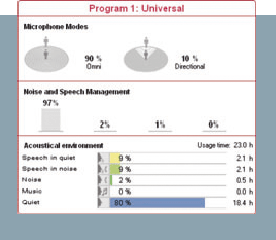
- The comfort of the sound in a variety of situations including your own voice
- The improvement in hearing provided in a variety of situations, especially when background noise is present.
It is up to your hearing specialist to ensure that there aren’t any issues limiting your use to less than four (4) hours per day on average.
You should also keep this minimum figure in mind as less usage per day tends to lead to a situation where you might stop wearing the instruments despite it providing benefit in some situations. We have an article discussing the issue of non-use here.
Follow-ups after the initial fitting are critical to achieving consistent and beneficial use. Modern digital hearing aids keep data logging information that clearly shows the clinician what your average daily use was since you last saw them.
Longer-term recalls ensure that this usage does not start tapering off over time. If it does, then the clinician can do something about it to help you achieve a long-term benefit. As such at least six (6) monthly clinician visits are recommended. Have a look at our client journey to see what a solid plan for long-term benefit looks like.
Choose hearing aids that suit your hearing loss configuration and severity
Each individual with hearing loss has different hearing loss configuration and severity (audiogram). Modern hearing aids can be adjusted by the clinician to suit a range of hearing loss. This is great news because it means that even if your hearing loss changes a bit, your hearing aid can keep up.
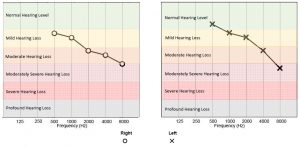 Just because a hearing aid can suit a certain loss, it does not mean it is the best hearing aid to choose for that loss. When a hearing aid is selected the clinician needs to keep in mind the maximum power that the aid can deliver as well as how well it processes soft sounds. A hearing aid that “chops off” louder sounds might not suit someone with profound or severe hearing loss. A hearing aid that does not do well with soft sounds might not provide someone with milder hearing loss access to the softer sounds they need. Musicians need to also seriously consider sound quality when selecting a hearing aid as some hearing aids do much better with music than others.
Just because a hearing aid can suit a certain loss, it does not mean it is the best hearing aid to choose for that loss. When a hearing aid is selected the clinician needs to keep in mind the maximum power that the aid can deliver as well as how well it processes soft sounds. A hearing aid that “chops off” louder sounds might not suit someone with profound or severe hearing loss. A hearing aid that does not do well with soft sounds might not provide someone with milder hearing loss access to the softer sounds they need. Musicians need to also seriously consider sound quality when selecting a hearing aid as some hearing aids do much better with music than others.
You should be able to manage the hearing aid you choose
Hearing aids come in all shapes and sizes and many are quite small.
Your clinician needs to ensure that you are able to handle any hearing aid prescribed to you. You also need to be able to effectively keep it clean and operational; otherwise, you might run into difficulties with the device breaking down later in its life. To see what sort of care might be required, we have a troubleshooting guide available here.
Your choice of hearing aid should optimise your maximum ability to understand speech in quiet
During your initial hearing test, you should be asked to repeat some words in quiet. This test is designed to determine your maximum speech understanding in quiet as a percentage of sounds /words correct.
A properly selected and carefully fitted hearing aid should allow you to hear at least this well in quiet. A poorly selected and fitted option may make things too loud; soft or could even cause distortion. This may negatively affect your ability to understand speech even in relatively easy situations, like in quiet.
NOTE: If your measured ability to hear speech in quiet is poor, then you cannot expect even the best hearing aid to give you any better understanding of speech than your brain is capable of processing.
There should be no difference between a basic or premium hearing aid that is properly fit when it comes to improving your hearing in quiet.
One certainly needs to ensure that you select a hearing aid with the best possible sound quality to maximise enjoyment, but this is available in all levels of technology. Some technologies are critical to the best sound quality.
Your best hearing aid is the one which optimises your unique ability to understand speech in noise
Hearing aids differ immensely in their ability clear up speech in the presence of background noise. This difference is not only between manufacturers but is even more noticeable between different technology levels.
To be able to accurately select your best hearing that will also work for you in noise, one needs to take into account your inability to understand speech in noise using a speech-in-noise test. These results can the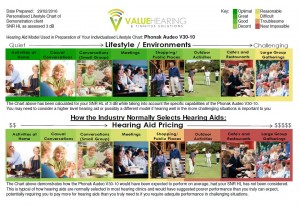 n be used to match your inability to a specific hearing aid’s ability to improve speech in noise. Combining this with the other factors (severity and hearing in quiet) then gives you a hearing solution that will work well for you in all situations. We have an article here about improving hearing in noise using hearing aids.
n be used to match your inability to a specific hearing aid’s ability to improve speech in noise. Combining this with the other factors (severity and hearing in quiet) then gives you a hearing solution that will work well for you in all situations. We have an article here about improving hearing in noise using hearing aids.
Note: Unfortunately most hearing tests available in Australia today don’t include speech in noise testing. Even if they do, we are not aware of any other that actually matches technology’s ability to improve speech in noise to an individual’s inability to understand speech in noise as precisely as our unique process does. Value Hearing includes speech in noise testing as standard in all our tests and it is a vital part of our hearing aid selection process.
We have an article here which details what to expect from a comprehensive hearing assessment.
Choose a hearing aid that suits your lifestyle
Hearing aids have many features which are lifestyle dependent. These include wind noise cancellation, speech in car, special music settings, theatre and phone options.
Your best hearing solution should allow you to use it in a variety of situations with as little bother as possible. We find that too many little issues add up and may result in you giving up on the solution over time.
Note: Most providers use lifestyle to recommend a certain level of hearing technology based on how active you are in noisy situations (e.g. Restaurants). This approach assumes an average (poor) speech-understanding-in-noise score (see the point above) and often leads to over-prescription of hearing aids (selling you pricey technology you don’t need). The ability of the brain to clean up speech in noise is conveniently ignored in this approach. Younger, more active people, who actually tend to have better natural ability to hear in noise, are then recommended very expensive hearing aids, with features they don’t need.
We have an article dedicated to explaining the quality differences between different levels of technology here.
Why pay for the hearing aid to do things your brain is much better able to do once it can just hear?
Your best hearing aid choice is the one that provides the best value without over- or under-prescribing
Once you know all the things you need to consider to find your best hearing aid, you need to look at which device covers all these factors. You don't want to overshoot your needs as it will tend to be more expensive (without providing additional benefits). Undershooting your needs might lead to dissatisfaction and disappointment over the long term.
Sometimes an individual’s hearing might be too poor for any hearing aid to fully correct. This does not mean that you won’t receive any benefit; you just need to understand what to realistically expect. There are also a variety of accessories that can improve the hearing aid's performance in a multitude of situations.
Being aware of your unique limitations with hearing aids will help avoid disappointment and can also open the door for exploring additional technologies to improve your ability to effectively communicate and engage.
Choose hearing aids you can afford
Knowing what you need is one t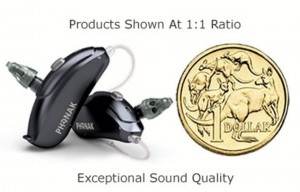 hing, but being able to afford it, especially if a higher cost option is prescribed, is another.
hing, but being able to afford it, especially if a higher cost option is prescribed, is another.
Sometimes you need to make compromises when considering your best hearing aid due to financial concerns.
There is assistance available from Private Health insurance and payment plans exist.
Just make sure you don’t compromise to the level where you won’t use the hearing aid due to any of the issues discussed earlier.
We have an article dedicated to the funding options for hearing aids in Australia.
NOTE: Hearing aid prices in Australia are not regulated. Find out how any quotes you have received elsewhere compares here.
A question we get asked regularly is, why don't we just list hearing aid prices online?
Even though we offer exceptionally good value on our hearing aids, we choose not to list prices because:
- Your best hearing aid for long-term benefit cannot be chosen on price alone. How does pricing reflect which hearing aid will work for you?
- Price does not reflect the model's capability to address your needs. For some, a very basic hearing aid might work as well as a very expensive model. For others, nothing less than the best noise reduction aid will suffice, while for others, irrespective of how much you pay, you will still struggle in some situations.
- You are not simply purchasing a piece of advanced computer equipment. It takes expert adjustment, counselling, ongoing care and optimisation to ensure the choice of hearing aid keeps delivering results. So the hearing aid prices given online vary greatly. Some quote the aid alone without services, while others include guaranteed long-term outcomes and services.
- Even if you choose us based on a specific price, which we are happy to provide by email or by phone, you may not end up with that device. Our role is to help you find the best device, out of the hundreds available that will help for years to come.
- Even if you had been recommended a hearing aid elsewhere that you'd simply like to compare the price of, the motivation behind that recommendation may be profit/commissions driven or limited by available choice. Some people who come to us end up with less expensive options, while others require more premium technology, while others may not need hearing aids at all.
How Do I ensure I choose My Best Hearing Aid?
Check your motivation
Make sure you are ready to put in the time and a little bit of effort to make the hearing solution work. The hearing aid is just a part of the solution. Your brain needs time to adjust and for that to happen you need to consistently use it. Even the best hearing aid does not improve hearing if it is not worn.
Choose an independent hearing provider with a large range of hearing aid brands
The vast majority of hearing clinics in Australia are tied to specific manufacturers. This may severely limit your choice to mainly those devices they supply. Ask the provider if they are independent and make sure they have access to at least 4 or 5 different brands. This dramatically increased your odds of finding your best hearing aid.
Undergo a Comprehensive assessment that includes speech in noise testing
Hearing tests can be had pretty much anywhere and vary in cost from free to a couple of hundred dollars. The cost is not really a determinant of the quality of the assessment.
What is more telling is the time spent (look for at least 90 minute appointments) and what tests are included.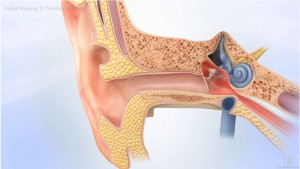
Many hearing assessments are like two-legged stools. They only assess your hearing severity and ability to hear speech in quiet (some tests even leave this out!). They do not perform a critical speech in noise test, needed to accurately identify the ideal level of technology, which makes up the third leg of the stool.
So always ask: “Do you use speech-in-noise testing as part of your test?”.
If this is done, you should be presented with sentences you need to repeat in the presence of background noise (pub-like noise, NOT hissing) during the test.
Choose a provider that includes speech in noise testing results in their hearing aid selection
Just the fact that a provider performs a speech in noise test, does not mean they use this in the hearing aid selection process.
Be wary of providers who focus on your budget and/or shows you charts with different technologies, where the more active you are socially the more expensive hearing aids you require.
They often give you multiple choices and you have to pick one. How are you supposed to know which is your best hearing aid, if they can't tell you?
Ask them: “how does this relate to my hearing in noise results?”
Ask questions if answers aren’t forthcoming
After a comprehensive, empowering hearing assessment, you should have absolute clarity on the nature of your hearing loss, what to do about it and what your best hearing aid or next step is.
If this is not the case, ask questions. It is your hearing and you will have to live with the recommended solution for a long time (5+ Years)
Make sure you have a sufficiently long trial period with the hearing aid of your choice
There two kinds of hearing aid trials:
- Short term free trials designed to get you to buy the most expensive hearing aids and;
The first option is often advertised along the lines of an open day or “We need 30 participants for a research project on the latest hearing aids….”. Alternatively, hearing aid trials can be used as a proof of concept only.
The reasons for this are:
- The demonstration hearing aids used for trials are almost always the most expensive the specific manufacturer has to offer and not necessarily the one which best matches all your needs and hearing loss requirements.
- They are often just quickly set to a pre-calculated average for your hearing loss, rather than being calibrated exactly to your ears
- You don’t have them for long enough to get past the initial honeymoon period
- You don’t have a fine tuning opportunity during the trial to improve them as you get used to them
- If you do decide to buy, you don’t keep the ones you trialled, so other issues may result
- Long term money back guarantee periods where you can actually use and adjust to your best hearing solution of a period of 30 to 60 days
In this trial situation, you actually purchase your prescribed best hearing aid and then have a period of up to 60 days during which you can return the hearing aids if you are not satisfied for any reason. There may also be an opportunity to exchange for another model if the initial recommendation proves to be less than ideal with use.
The advantages of this approach are:

- You get to use the exact device you will end up within the long term if you proceed past the trial period
- The device is fitted carefully to your hearing levels and customised precisely for your loss
- You have opportunities to have it fine-tuned as needed during follow-up visits (make sure these are unlimited during the trial period so you can get things right)
- Your brain has time to completely adjust to the solution
- You get past time to get past the honeymoon period so you understand exactly what to expect in the long term from the solution
Make sure you have an option to refund or exchange if things don’t work out as expected
Most clinics offer a money back guarantee. The period for the guarantee may be as short as 14 days and as long as 60 days. Some money back guarantees allow a full refund, while others are just partial.
Obviously a longer money back (trial) period is better and a full refund is better than a partial one. Make sure you ask about the provider’s money back guarantee policy.
As an example, Value Hearing offers a 60 Day Full Money Back Guarantee, to ensure that the hearing aid you choose is really the best hearing aid for you.
